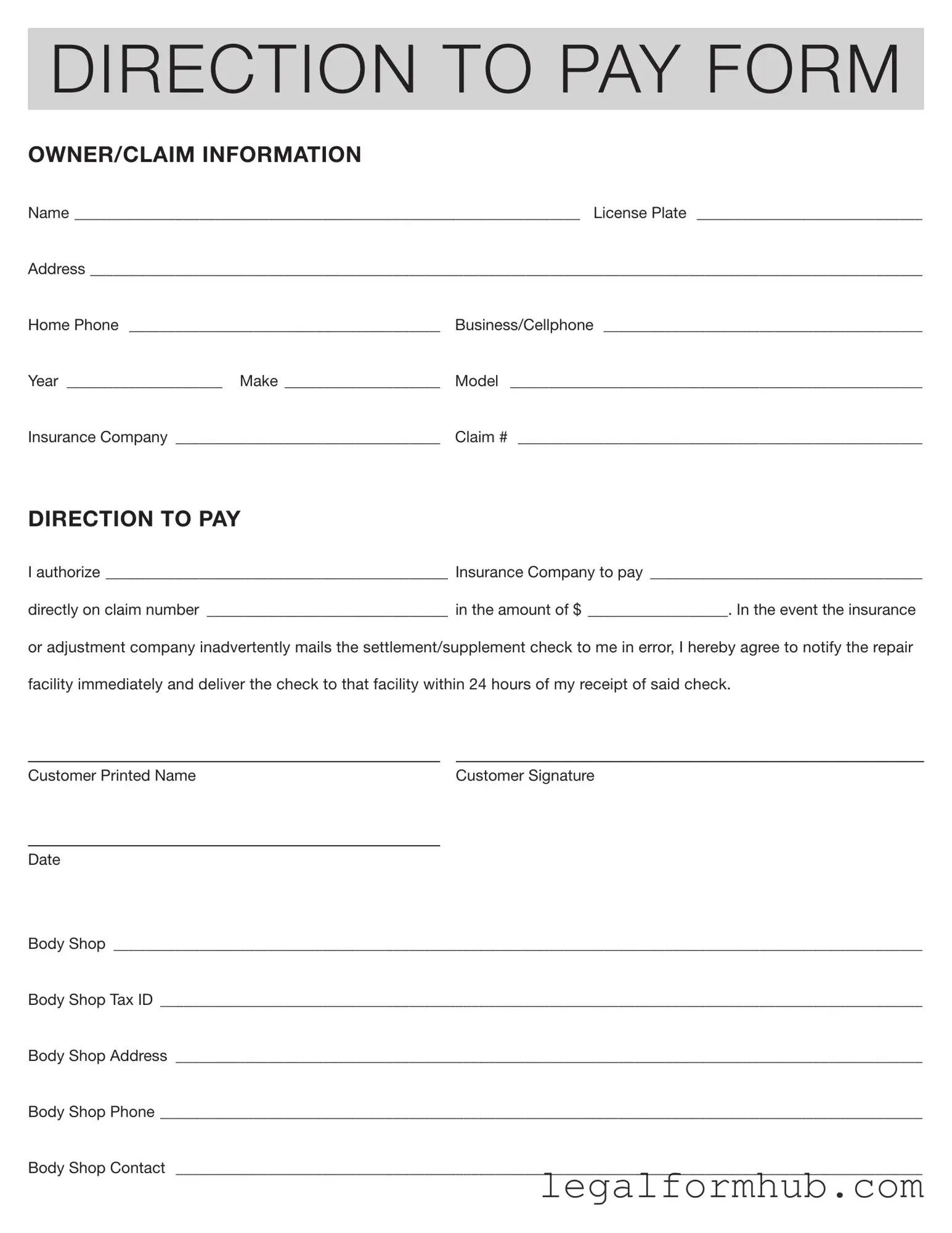The Authorization and Direction to Pay form shares similarities with the Assignment of Benefits (AOB) document. An AOB allows a policyholder to transfer their insurance benefits to a third party, such as a contractor or repair shop. This means that the third party can directly receive payment from the insurance company for services rendered. Like the Authorization and Direction to Pay form, the AOB requires the policyholder's consent, ensuring that they are aware of and agree to the payment arrangement.
Another document akin to the Authorization and Direction to Pay form is the Power of Attorney (POA). A POA grants an individual the authority to act on behalf of another person in legal or financial matters. While the Authorization and Direction to Pay form focuses specifically on directing payment for a claim, a POA can cover a broader range of actions. However, both documents require clear consent from the individual granting authority, ensuring that their interests are protected.
The Release of Liability form is also similar in nature. This document is used to relinquish any claims against a party after a settlement has been reached. While the Authorization and Direction to Pay form directs payment to a specific entity, the Release of Liability signifies that the claimant has received their due compensation and agrees not to pursue further claims. Both forms aim to clarify the terms of payment and protect the involved parties.
Additionally, the Claim Assignment form bears resemblance to the Authorization and Direction to Pay. This document allows a claimant to assign their rights to receive payment for a claim to another party. Like the Authorization and Direction to Pay form, it requires the claimant's signature and ensures that the insurance company knows who is entitled to the payment. This helps streamline the claims process and minimizes confusion regarding payment recipients.
The California Employment Verification form is a key document for confirming an employee's work eligibility in California. It captures vital details to ensure adherence to regulations, playing a significant role in the hiring process. For further assistance with employment documentation, you can visit Fill PDF Forms to streamline your application process.
The Insurance Settlement Agreement is another related document. This agreement outlines the terms under which an insurance settlement is reached. Similar to the Authorization and Direction to Pay form, it typically requires the claimant's signature, indicating their acceptance of the settlement terms. Both documents serve to formalize the agreement between the claimant and the insurance company, ensuring that everyone is on the same page regarding payments.
The Indemnity Agreement is also comparable. This document protects one party from financial loss caused by the actions of another. While it may not directly involve payment direction, it often accompanies other forms like the Authorization and Direction to Pay. Both documents emphasize the importance of clear agreements to avoid future disputes and ensure that all parties understand their responsibilities.
The Direct Payment Authorization form is closely related as well. This document allows a policyholder to authorize their insurance company to make payments directly to a service provider. Like the Authorization and Direction to Pay form, it requires the policyholder’s explicit consent and ensures that the service provider is compensated without delay. Both forms streamline the payment process and enhance communication between all parties involved.
Another similar document is the Insurance Claim Release form. This form is used to release the insurance company from any further claims once payment has been made. While the Authorization and Direction to Pay form focuses on directing the payment, the Insurance Claim Release form ensures that the claimant acknowledges receipt of the payment and agrees not to pursue additional claims. Both documents serve to finalize the claims process and provide clarity to all parties involved.
Lastly, the Settlement Statement is comparable to the Authorization and Direction to Pay form. This document summarizes the terms of a settlement, including the amounts to be paid and to whom. While the Authorization and Direction to Pay form specifically directs payment for a claim, the Settlement Statement provides a broader overview of the settlement agreement. Both documents aim to ensure transparency and clarity regarding financial transactions related to insurance claims.
